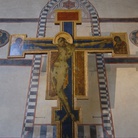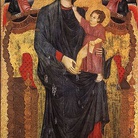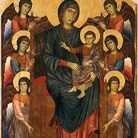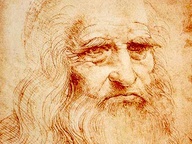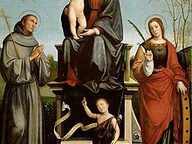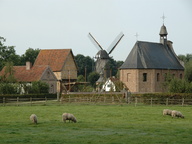The frame is decorated with twenty-six painted medallions depicting Christ and four angels, as well prophets and saints. This is one of Cimabue's early works, painted in about 1280, well before the Maestà di Santa Trinità (Florency, Uffizi). A lack of consensus in attributing this painting to the Florentine master is due in large part to the later date of execution traditionally assigned to it, difficult to reconcile with the hieratic and dramatic style.
The iconography of the Maestà - the Child and the Virgin, glorified as queen of heaven, and surrounded by a host of angels - is accentuated by the monumentality of the retable and the sumptuous gold ground. On the original frame, twenty-six painted medallions depict Christ and four angels, as well as saints and prophets.
This work was described by Vasari in 1568 as being found in the church of San Francesco in Pisa, whose high alter it adorned. For this reason, certain specialists have linked this work with Cimabue's stay in Pisa from 1301 to 1302. However, stylistic analysis of the painting and comparisons made between it and the Maestà painted at a later date for the Santa Trinità church in Florence (Florence, Uffizi) suggest an earlier date of execution - around 1280. Nevertheless, the work already contains elements that attest to the investigations and aspirations of the artist responsible for the rebirth of painting in Italy.
Cimabue led the artistic movement in late 12th-century Tuscany that sought to renew the pictorial vocabulary and break with the rigidity of Byzantine art. The artist demonstrated a new sensibility, which endeavored to adhere more closely to reality.
The composition of the Maestà is symmetrical and dense. The imposing Virgin is hieratic, and the blessing gesture of the Christ Child is hardly child-like; however, Cimabue gently and subtly models the faces, endowing the figures with a new sense of humanity. The drapery, not simply drawn either, seems to fold naturally, following the movement of the bodies (for example, the cloaks of the two angels in the foreground whose knees protrude). This demonstrates the undoubted influence of sculptors such as Nicola Pisano.
COMMENTI
LE OPERE
Map
Works in Italy
Works around the world
